Power is a great luxury enjoyed by many. This is true especially in the Florida summer. We love our air conditioning, functioning fridges, etc. Any time the power goes out, it is stressful. Your house can get hot, your food may go bad, it is generally not a great time. One way to keep the power flowing is for utility companies to maintain trees around power lines.

Before we get into more about tree management, let’s talk about the different power lines. There are two overall categories of lines. Transmission lines move power from the source to substations. They also move large amounts of power between substations. These lines are high voltage (usual 69kV-500kV) and under both FERC and NERC regulations. Think of these as rivers of electricity. If one of these goes out, thousands to millions of people could be without power. These lines are not coated, and electricity can arch from the lines to anything that is too close to them, including trees. Distribution lines deliver power to homes and businesses from substations. These lines are lower voltage (120/240 volts), and have a protective coating on them. While these do not have the same set of regulations, they are the ones that are generally most noticed by residents.

Trees and power lines often come into conflict. While occasionally power lines are installed after trees are established, many times trees are planted too close to existing powerlines. There are a few ways to reduce the conflict between trees and power lines. One is pruning, the other is not planting trees too close to power lines. If you have large established trees near power lines, trimming is often the best option. Power companies conduct maintenance trimming on a regular basis, but you can request an inspection for work if you think there is something that endangers the line. Keep in mind, that the line attached to your home is your responsibility to maintain as far as plant maintenance goes.

If you plant trees, keep them at least 20 feet from power lines. This reduces possible future conflicts between trees and power lines. Be sure to determine that maximum spread of the tree to ensure that 20 feet is enough space for the tree to grown. Not all trees are appropriate to grow near power lines. Never plant directly under distribution power lines. Never plant anything with a mature height of over 12 feet under a transmission power line.
Direct questions or concerns about your trees and power lines to the power company that owes the line. While this can be that company that you pay your power bill to, that may not always be the case. Start with your power company for more information.
Additional Resources:
https://www.treesaregood.org/Portals/0/TreesAreGood_Avoid%20Utility%20Conflict_0621.pdf
https://www.arborday.org/programs/treelineusa/standards.cfm
 1
1
